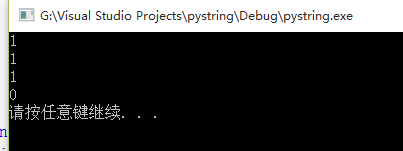【C++实现python字符串函数库】字符串匹配函数startswith与endswith
这两个函数用于匹配字符串的开头或末尾,判断是否包含另一个字符串,它们返回bool值。startswith()函数判断文本的指定范围字符段是否以某个字符开始,endswith()函数判断文本是否以某个字符结束。默认的指定范围为整个字符串:
>>>
>>> a
'abcdefghijklmn'
>>> a.startswith('abc')
True
>>> a.endswith('klmn')
True
>>> a.startswith('bc')
False
>>> a.endswith('nm')
False
>>>
也可以指定一个匹配范围:
>>>
>>> a
'abcdefghijklmn'
>>> a.startswith('cd',2,10)
True
>>>
python字符串范围校准。
在使用字符串函数时,很多时候我们可以使用start与end参数来指定要进行操作的字符串的一个范围。例如在上面的函数中我们就使用到了('cd',2,10)语句,来对字符串a下标从2~10的范围进行匹配操作。
当我们输入的范围不合法时,python是如何处理的呢?例如我们输入了一个负数的start或者输入一个远大于字符串长度的end,python的处理绝不是以字符串开始或结束位置作为标准来校正范围,请看下面这段程序:
>>> a
'abcdefghijklmn'
>>> len(a)
14
>>> a.startswith('ef',-10,10) #实际范围:(-10+14,10)=(4,10)
具体的校准方法,我们可以使用这函数来描述:
void AdjustIndices(int &start, int & end, std::string::size_type len)
{
len =(int)len;
//如果end超出字符串长度
if (end > len)
end = len; //则以字符串长度为准
else if (end < 0)
{//如果end为负数
end += len; //则先加上字符串长度
if (end < 0)//如果还是为负数
end = 0;//则为0
}
//如果start为负数
if (start < 0)
{
//则加上字符串长度,注意不是以0校准
start += len;
if (start < 0)//如果还是负数
start = 0;//才以0校准
}
}
然而在我们的函数库实现中,我们并不打算把范围校准操作作为一个函数。我们将它作为一个宏来处理,原因如下:
- 操作简单,不会出来宏函数常见的问题,直接的替换足以解决问题。
- 省去函数调用的花销
- 多个地方都需要范围校准。
C++实现
范围校准宏
#define ADJUST_INDICES(start, end, len)
if (end > len)
end = len;
else if (end < 0) {
end += len;
if (end < 0)
end = 0;
}
if (start < 0) {
start += len;
if (start < 0)
start = 0;
}
有上面的解说,这段宏定义应该看得懂。
_string_tailmatch函数
//匹配函数:endswith与startwith的内部调用函数
int _string_tailmatch(const std::string&self, const std::string&substr, int start, int end, int direction)
{
int selflen = (int)self.size();
int slen = (int)substr.size();
const char* str = self.c_str();
const char* sub = substr.c_str();
//对输入的范围进行校准
ADJUST_INDICES(start, end, selflen);
//字符串头部匹配(即startswith)
if (direction < 0)
{
if (start + slen>selflen)
return 0;
}
//字符串尾部匹配(即endswith)
else
{
if (end - start<slen || start>selflen)
return 0;
if (end - slen > start)
start = end - slen;
}
if (end - start >= slen)
//mcmcmp函数用于比较buf1与buf2的前n个字节
return !std::memcmp(str + start, sub, slen);
return 0;
}
endswith函数
bool endswith(const std::string&str, const std::string&suffix, int start = 0, int end = MAX_32BIT_INT)
{
//调用_string_tailmatch函数,参数+1表示字符串尾部匹配
int result = _string_tailmatch(str, suffix, start, end, +1);
return static_cast<bool>(result);
}
startswith函数
bool startswith(const std::string&str, const std::string&suffix, int start = 0, int end = MAX_32BIT_INT)
{
//调用_string_tailmatch函数,参数-1表示字符串头部匹配
int result = _string_tailmatch(str, suffix, start, end, -1);
return static_cast<bool>(result);
}
测试
string str = "abcdefghijklmn";
string temp1 = "ab";
cout << startswith(str, temp1)<<endl;//使用默认参数
string temp2 = "mn";
cout << endswith(str, temp2) << endl;
string temp3 = "ef";
cout << startswith(str, temp3, 4, 10)<<endl;
string temp4 = "qq";
cout << startswith(str, temp3, 0, 100) << endl;
测试结果
